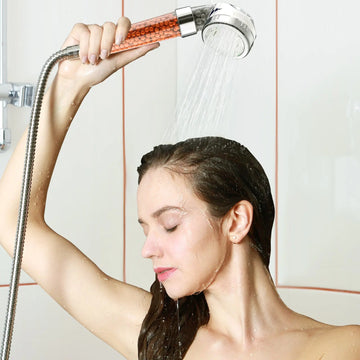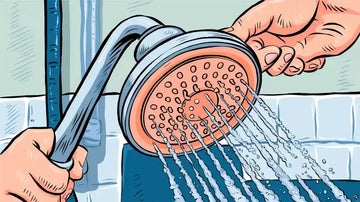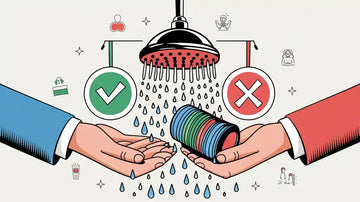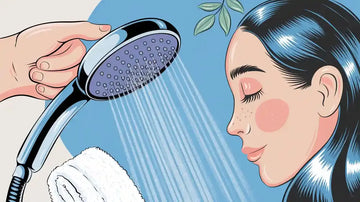Ready to make a difference in your bathroom? You can save water every day with a few simple strategies. Try water saving shower heads, fix leaks, and change up your habits for big results. Check out these quick tips that really work:
Take shorter showers. Cutting just one or two minutes saves up to 150 gallons a month.
Turn off the tap while brushing your teeth or washing your hair. You could save another 25 to 150 gallons each month.
Repair leaks right away. Even a small drip wastes gallons over time.
Did you know? Using water-saving showerheads can cut your water use by up to 40%. For a family of four, that means over 10,000 gallons saved every year! Check out this quick comparison:
Strategy |
Water Savings |
|---|---|
Water-saving showerheads |
Up to 2,700 gallons/year |
Fixing leaks |
Immediate, ongoing savings |
Shorter showers |
150 gallons/month |
Small changes add up fast. Your daily choices support water conservation and help the environment.
Key Takeaways
Use water-saving shower heads. They can cut water use by up to 40%. You will not lose water pressure. Fix leaks fast. This stops wasting thousands of gallons of water. It also lowers your water bill. Take shorter showers. Turn off the tap when brushing teeth or washing. This can save hundreds of gallons each month. Upgrade to water-efficient fixtures. Try low-flow toilets and faucet aerators. These give big and lasting savings. Get your whole family to help. Watch how much water you use. Saving water is a team effort. You can also find problems early.
Water Savings Strategies
Are you trying to save water in your bathroom? You can use some easy strategies that really help. These ideas are simple to try and can lower your water bill. They also help the environment.
Strategy |
Evidence Summary |
Effectiveness & Ease of Implementation |
|---|---|---|
High-efficiency toilets |
EPA says new toilets can save at least 20% water each year. Replace old toilets with ULTF or HET models for savings. |
Each toilet can cost up to $400. You will likely save money soon. Many businesses use them. LEED credits support this change. |
Low-flow urinals |
High Efficiency Urinals use much less water per flush, like 0.125 GPF. |
They are easy to swap out. LEED recognizes the water savings. Be careful with sensor urinals, as they may flush by mistake. |
Water-efficient faucets |
These faucets use about 20% less water and energy. You do not have to change your habits. |
They are simple to put in. They work well in bathrooms. You do not need to do anything different. |
Fix Leaks
Leaks waste water without you noticing. A small drip can waste a lot over time. Most homes lose almost 10,000 gallons of water each year from leaks. A broken showerhead can waste over 500 gallons in a year. About 10% of homes have leaks that waste more than 90 gallons every day. If you check for leaks and fix them fast, you can save about 10% on your water bill. Look for dripping faucets, running toilets, or water under sinks. Fixing leaks saves water and money.
Shorter Showers
Showers use a lot of water. Longer showers mean more water is used. Studies show that shorter showers save a lot of water. Using a shower sensor can help people take shorter showers. Some people cut their shower time by over 13%. Others saved even more, up to 21%. Taking shorter showers can save hundreds of gallons each year. Try using a timer or play a song to keep your shower short.
Turn Off the Tap
Leaving the tap on while brushing your teeth or washing hands wastes water. Running a faucet for five minutes uses as much energy as a 60-watt bulb running for 14 hours. Turning off the tap saves water and energy. The Colgate 'Save Water' campaign showed that turning off the tap can save billions of gallons around the world. You can also turn off the shower while shampooing or shaving. Every small action helps!
Tip: Small changes, like using water saving shower heads and these strategies, can lead to big savings over time.
Water Saving Shower Heads
Benefits
You might not realize how much water you use during showers. Standard showerheads use about 2.5 gallons per minute. Water saving shower heads cut that down to 2.0 gallons or even 1.5 gallons per minute. That means you save about 2,700 gallons of water every year just by switching. Less water used also means less energy needed to heat it, so you save on your utility bills, too.
Showerhead Type |
Flow Rate (gallons per minute) |
Daily Water Use (gallons per person) |
|---|---|---|
Efficient |
1.5 |
12 |
Standard |
2.5 |
20 |
Water-saving showerheads help you use less water without giving up a good shower. Studies show that these showerheads can cut your water use by about 10%. Some people even take shorter showers when they see how easy it is to save.
Tip: Showers can use up to one-third of all the water in your home. Making this one change can have a big impact!
Choosing the Right Model
Not all water saving shower heads are the same. Some models, like the Cobbe DS Filter Shower Head, do more than just save water. This shower head uses a 20-stage filtration system with KDF-55 and calcium sulfite to remove chlorine and heavy metals. You get cleaner water for your skin and hair. It also has a built-in flow restrictor and a special piping design, so you still get strong water pressure. You can pick from five spray modes, including a water-saving setting, to match your mood.
When you shop, look for WaterSense labeled products. These meet strict standards for water efficiency and performance. Some water-efficient shower head models also offer extra features like adjustable spray patterns or filtration. Low-flow showerheads with these features give you comfort and savings at the same time.
Easy Installation
You do not need to be a plumber to install a new shower head. Most water saving shower heads, including the Cobbe DS Filter Shower Head, take about 15 minutes to put in. You just unscrew the old one, wrap plumber’s tape around the threads, and screw on the new one by hand. No special tools needed. Check for leaks, and you are done! This quick upgrade makes it easy for anyone to start saving water right away.
Efficient Fixtures
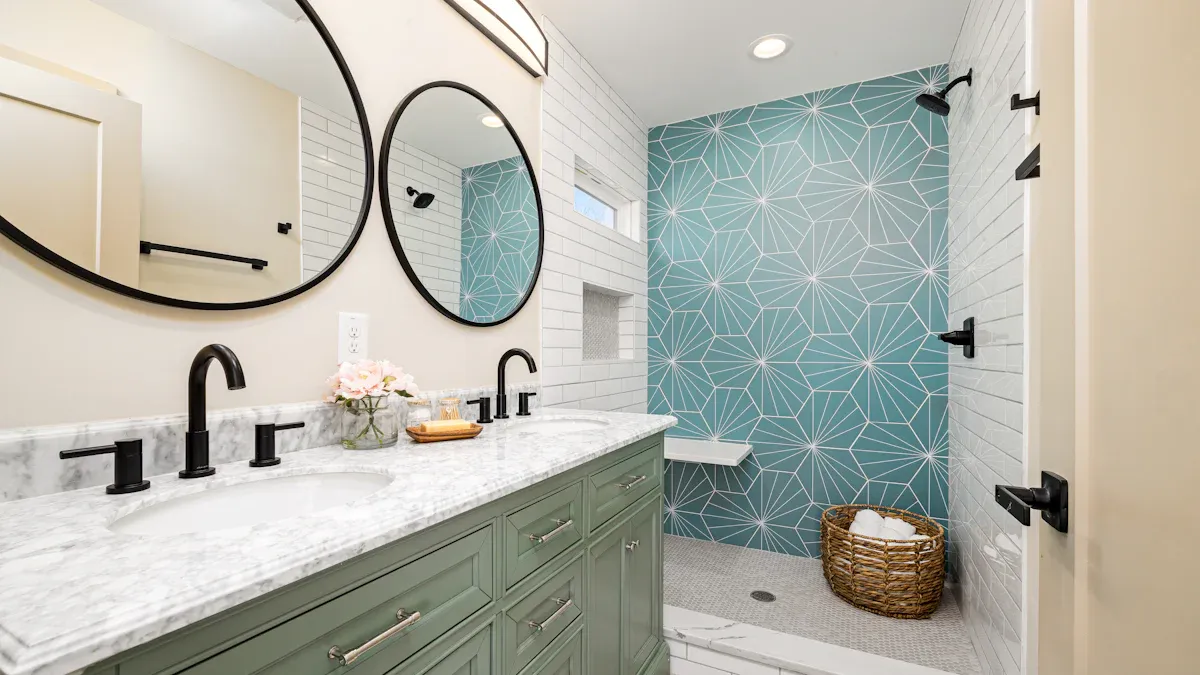
Low-Flow Toilets
You might not think about your toilet much, but it uses more water than almost anything else in your bathroom. If you still have an older toilet, you could be flushing away thousands of gallons every year. Modern water-efficient fixtures, like a dual-flush toilet or a low-flush model, use much less water per flush. A standard toilet can use up to 3.5 gallons each time you flush. In comparison, a water-efficient toilet uses only about 1.6 gallons or less. Some dual-flush toilets let you pick a lower flush for liquid waste and a higher one for solids, so you save even more.
Here’s a quick look at how much water you can save:
Toilet Type |
Gallons Per Flush (gpf) |
Annual Water Usage (gallons) |
Relative Usage Compared to Standard |
|---|---|---|---|
Standard Toilet |
3.5 |
27,300 |
100% |
Low-Flow Toilet |
1.6 |
12,500 |
46% |
Switching to water-efficient fixtures can cut your bathroom water use by at least 20%. Over time, this adds up to big savings on your water bill. If you choose a dual-flush toilet, you get even more control over your water use. Many families save up to $170 a year just by upgrading their toilets.
Tip: Replacing old toilets with a dual-flush toilet is one of the easiest ways to make your bathroom greener and save money.
Faucet Aerators
Faucet aerators are small devices that screw onto the tip of your bathroom faucet. They mix air with water, so you get a steady stream without using as much water. Most older faucets use about 2.5 to 3.0 gallons per minute. When you add a low-flow aerator, you can cut that down to 1.5 gallons per minute or less. That’s a 15% to 30% drop in water use, just from one simple change.
Many water-efficient fixtures, like WaterSense-labeled aerators, help you save even more. Studies show that families can save around 700 gallons of water each year by installing these. You also get a softer, splash-free stream that feels just as good as before. Some public restrooms have seen water use drop by up to 70% after switching to sensor faucets with aerators.
Note: Faucet aerators are cheap, easy to install, and low maintenance. You can start saving water in minutes!
Save Water Tips
Reuse Water
You can make a big difference by reusing water at home. Water from your shower, sink, or laundry—called greywater—makes up most of your household wastewater. With the right treatment, you can use this water again for things like flushing toilets or watering your garden. This helps with conservation and keeps your water bills lower.
Here are some ways people reuse water safely:
Greywater treatment systems clean water from showers and sinks so you can use it for toilet flushing or irrigation.
Nature-based solutions, like small garden wetlands or biofilters, remove chemicals and germs from greywater.
Advanced systems use filters and UV light to make greywater safe for reuse.
Many homes install these systems right in the greywater supply line, so treated water goes straight to your garden or toilet.
If you want to try reusing water, check your local rules first. Some places have special guidelines for greywater use. When you use a water-saving bathtub, you can collect and reuse bathwater for your plants. This is a smart way to help with conservation and reduce waste.
Smart Habits
Simple habits can help you save water every day. You do not need fancy equipment—just a few changes in your routine. Check out this table for some easy actions and how much water you can save:
Water Saving Action |
Water Saved / Year |
|---|---|
Turn off water while brushing teeth |
|
Shorten shower by 1 minute |
|
Fix leaks quickly |
Cuts usage by 20% |
Use a water-saving bathtub |
Reduces bath water use |
Try these tips:
Turn off the tap when brushing your teeth or shaving.
Take shorter showers. Even one minute less makes a difference.
Fix leaks as soon as you spot them.
Choose a water-saving bathtub to cut down on water use.
Every small step helps with conservation. When you build these habits, you support water conservation and help protect our planet.
More Ways to Boost Water Savings
Involve the Family
Saving water works best when everyone in your home joins in. You can make a bigger impact if each family member helps out. Research shows that when more people in a household take part in water-saving efforts, the home uses less water overall. It does not matter if you use special tools or just change your habits. The key is to get everyone involved.
Try these ideas to make water saving a team effort:
Set up a family challenge to see who can take the shortest shower.
Make a chart to track who remembers to turn off the tap while brushing teeth.
Talk about why saving water matters at dinner.
Let kids help spot leaks or remind others to use the water-saving setting on the shower head.
When you work together, you can save more water and even lower your bills. You might also want to talk about using a tankless water heater. This type of heater gives you hot water only when you need it, so you do not waste water waiting for it to heat up.
Monitor Usage
You cannot manage what you do not measure. Keeping track of your water use helps you spot waste and fix problems fast. Many homes now use smart meters or leak detectors to watch water flow in real time. These tools can show you where you use the most water and help you find leaks before they become big issues.
Here is a quick look at some ways to monitor water use:
Monitoring Technique |
Description |
Benefit |
|---|---|---|
Real-time monitoring |
Meters and sensors track water flow and pressure. |
Find leaks and save water quickly |
Pressure management |
Controls water pressure to stop pipe bursts and leaks. |
Reduces risk of leaks |
Predictive maintenance |
Uses data to fix problems before they start. |
Prevents big leaks |
Asset management |
Digital tools show which pipes or fixtures need repairs. |
Cuts down on wasted water |
Data-driven decision-making |
Uses all the data to make smart choices about repairs and upgrades. |
Improves water efficiency |
You can start by checking your water bill each month. Look for sudden jumps in usage. If you want to go further, try a Wi-Fi-enabled monitor that tracks water use for each part of your home. Some families also use a tankless water heater to cut down on wasted water and energy. When you keep an eye on your water use, you can make changes that really add up.
You can help save water by fixing leaks and using water-saving shower heads. Making smart habits also helps a lot. Even one small change can make a big difference. Many places have saved lots of water by doing this:
Retail stores used up to 50% less water with low-flow fixtures and smart meters.
A university saved more than 650,000 gallons by using WaterSense showerheads.
Restaurants and schools saved millions of gallons with easy upgrades.
Every drop matters. Try a new habit today and tell us your best water-saving tip in the comments!
FAQ
How much water can I save by switching to a water-saving shower head?
You can save up to 2,700 gallons of water each year. That means lower bills and less waste. Water-saving shower heads use less water but still give you a strong, comfortable shower.
Do water-saving shower heads lower water pressure?
No, you still get great pressure. Many models, like the Cobbe DS Filter Shower Head, use special designs to keep the spray strong. You will not notice a big difference in how your shower feels.
What is the easiest way to check for leaks in my bathroom?
Place a few drops of food coloring in your toilet tank. Wait 10 minutes. If color appears in the bowl, you have a leak. Check under sinks for drips or puddles, too.
Can I install a water-saving shower head by myself?
Yes! Most water-saving shower heads twist on by hand. You do not need tools or a plumber. Just follow the instructions in the box. You can finish in about 15 minutes.
